On November 18, 2022, and after nearly two and a half years of an uphill legal battle, all charges against NDN Collective president and CEO Nick Tilsen related to a nonviolent direct protest in the Black Hills taking place on July 3, 2020, were finally dismissed by the state of South Dakota. Nick faced up to 17 years in prison after allegedly organizing a blockade and #LANDBACK protest in his Lakota homelands in response to former President Donald Trump’s visit to Mount Rushmore in 2020.
Since his arrest on that day, and alongside several other Land Defenders who were also arrested, it has been a long, drawn out legal battle. In this Q & A interview, Nick shares some of his reflections and big picture takeaways from the past two and a half years.
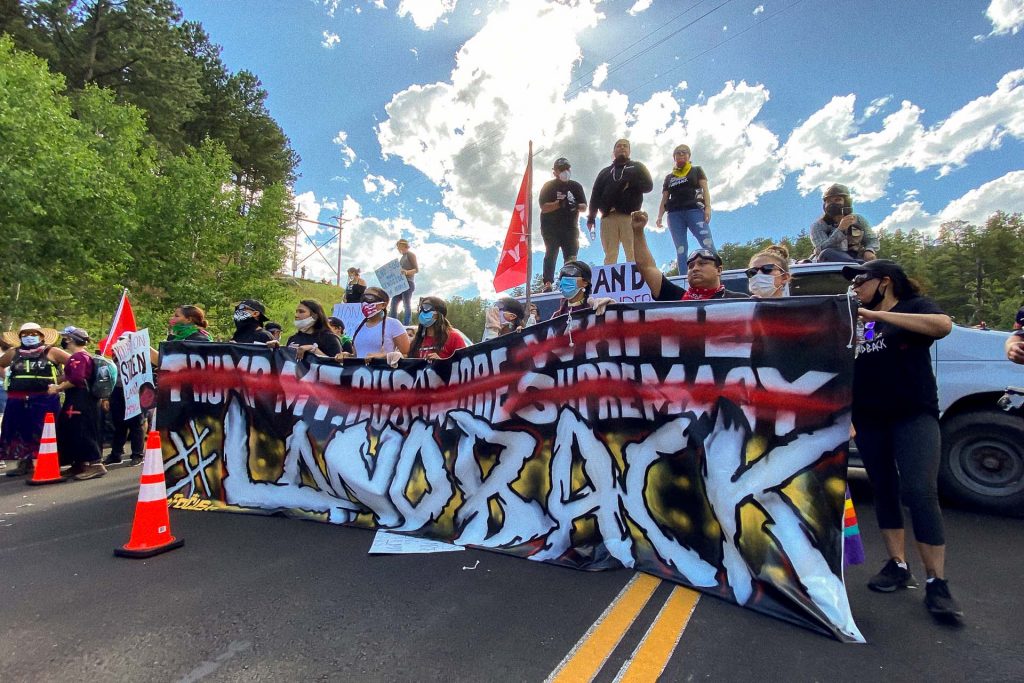
Q & A with Nick Tilsen
Q: This has been quite the journey, Nick. For 2.5 years, you have been fighting for your freedom and facing a potential 17 years behind bars. How are you feeling now that this legal battle is over and your charges are finally dismissed?
Nick: Honestly, it feels like a breath of fresh air. There is such a range of emotions and right now it feels like some weight off my shoulders, because when you’re doing this work, it’s a lot of pressure. There was a certain point where I thought I was going to prison. I have four children, and am extensively involved in their lives. The weight of holding that responsibility of being a parent, in addition to witnessing my children’s fear and worry throughout this whole experience, was heavy. There were times when they would resent my work as a result.
The other reality is that we’re in a state where Native Americans make up 9-percent of the population and yet make up 51-percent of the incarcerated population here in Rapid City, South Dakota. This is ground zero of the prison industrial complex in the United States. So this is the context that my personal struggle in the system exists within. It’s not only about my charges, but the bigger picture of how Native American people are targeted, then systematically oppressed by the carceral state.
Also, we knew these charges were trumped up from the beginning. I knew that the courts and the legal system chose to come at me this hard too because I am a highly visible leader and I because I’ve been leading an organization that is shaking the foundation of white supremacy.
I’m able to take a deep breath, which I haven’t been able to do in quite some time.
I also look at this from the lens of being a longtime community organizer, a direct action practitioner and someone who has been arrested plenty of times, but never charged to this degree and facing this much prison time. As direct action practitioners, our hope is always that the charges brought against us through direct action can be used as a tool against the system itself. We hold a mirror up to that system. Having done that in this case, we ended up victorious, and walked away with no charges, and no jail time.
So in the end, it’s a big ‘fuck you’ to the very system that we’re fighting. As a longtime organizer, I’m excited to be able to move on and to count coup* on the system. With this dismissal, there is finally a sense of relief and weight lifted off my shoulders and I’m able to take a deep breath, which I haven’t been able to do in quite some time.
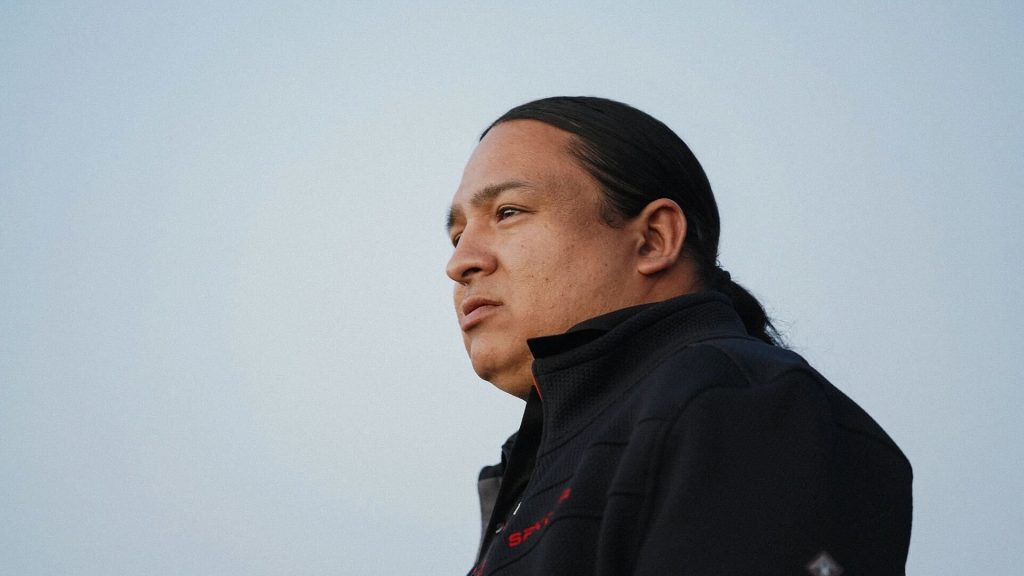
Q: Let’s talk about big picture strategy and the goals of this action on July 3, 2020. Do you feel like the strategy was successful and that your goals have been accomplished?
Nick: We have to put the timeframe of when my arrest happened into context. It was July 2020. We were in the middle of a pandemic in South Dakota. We had elders and knowledge-keepers passing away in unprecedented numbers because of COVID. Being at higher risk for COVID-related deaths in general, many Tribal Nations in South Dakota closed their reservation borders for community safety, and some even put up roadblocks. The governor of South Dakota, Kristi Noem, threatened Tribes for their actions to protect their communities, and threatened to call in the National Guard to dismantle Tribal roadblocks on reservations, and so Tribal leaders stood up to Governor Noem and the State of South Dakota.
You also had the murder of George Floyd and that uprising happening. You had the President of the United States declare that he was going to Tulsa, not for Juneteenth, but to try and rally his conservative base, also announcing that he was going to Mount Rushmore after that. At the same time, we also started to see confederate flags being taken down and statues across the country being toppled for the first time in the history of this country.
So many people throughout the country were going out into the streets and onto the frontlines, then you have the President who wanted to come to Mount Rushmore– which is a symbol of racism and white supremacy. You have to put all of those events into context and remember that NDN Collective, which is an international organization dedicated to dismantling white supremacy and building Indigenous power, whose headquarters is in the Ȟesápa, also known as the Black Hills, upheld the cultural context of this place of resistance. All of this is extremely important in understanding the action that we were involved in which took place in the Summer of 2020.
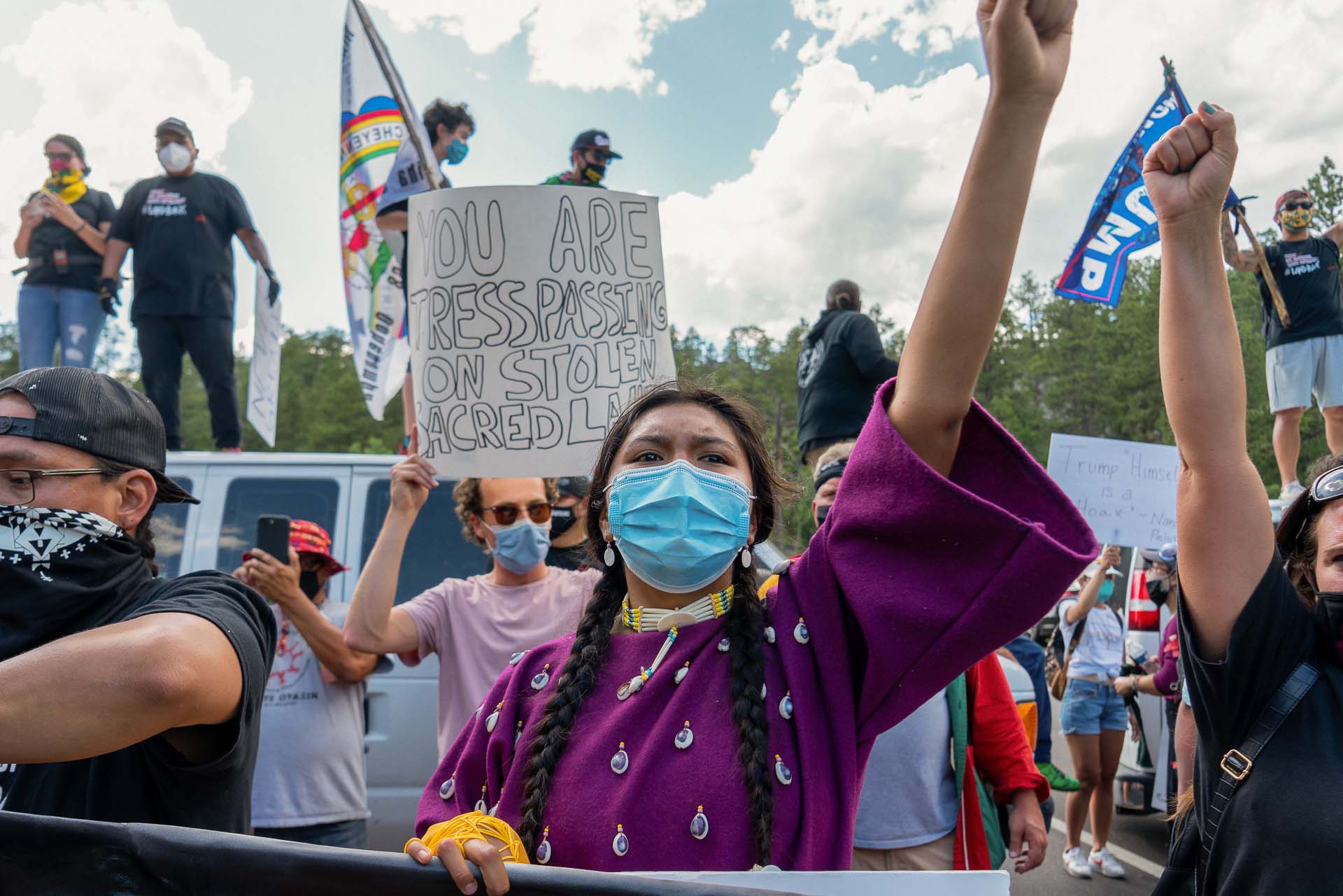
In speaking to the strategy, the purpose of the action had 4 focus points: 1) Asking the question of how we stand in solidarity with the Black liberation movement in an uprising; 2) how do we do it in a way that is directly connected to our struggle as Indigenous people; 3) reigniting of the fight for the HeSapa , which is one of the longest existing legal battles in United States history; 4) catalyzing the #LANDBACK movement into the mainstream and throughout Indigenous world as well as other communities. These were the goals and our strategy was to use nonviolent direct action. One of the reasons we engage in nonviolent direct action is because it’s something that almost everyone can do. Once you delve into high level politics so many people can feel disconnected from that. However, nonviolent direct action is more accessible, allowing for all people to hold space and stare into the eyes of the oppressor.
Being a Lakota, and being able to stand on your own homelands at that particular moment in time, we wanted to ensure that nonviolent direct action was utilized. We used it to create a blockade and built momentum prior to the action, using media and narrative strategy to set the tone to illustrate that there was going to be an ensuing battle. We wanted to get ahead of the narrative, and I feel like we had control of it long before Donald Trump landed in the Black Hills.
The amount of attention that this action garnered in bringing Land Back to a broader audience and inviting more people into the movement was successful.
You could feel in the air that something was going to happen and we understood that in that moment. We had enough wherewithal to recognize this and design a strategy that would make sense and gain attention, realizing that the entire White House press team, in addition to other major media outlets, would be present in the Black Hills and that this was a prime political moment to rise up, take advantage of the situation, and accomplish long-held goals. I will say this wholeheartedly— we accomplished all of those goals.
At the Black National Convention of 2020, the only video in that entire event that was shown and wasn’t produced by a Black person or wasn’t produced for a Black audience, was the Ȟesápa LANDBACK video, because it spoke to them. That’s an indication that the Black liberation movement did see us. Many of them reached out to us afterward, acknowledging that our struggle for the Black Hills and the stand we took that day connected to their struggle, and they appreciated how we stood up in solidarity with them.
In speaking to the reignition of the fight for the Black Hills, that battle has never ended, but has been uplifted by the younger generation. Numerous meetings about getting the Black Hills back have occurred because of this reignition. In terms of catalyzing the LANDBACK movement, which was really at that point in time only understood and known by Indigenous people and hadn’t broken into the mainstream yet, the goal was to ensure that society began to understand LANDBACK as a liberation framework for Indigenous people as well as a reparations and social justice framework. The amount of attention that this action garnered in bringing Land Back to a broader audience and inviting more people into the movement was successful.
To go to Washington, D.C. and to sit down with the Director of National Parks, Chuck Sams, who is Native, and discuss with him how we need to eventually shut down Mount Rushmore and return it to Indigenous people, was promising. Even to have a Native person in that position is powerful, and to hear him talk about several ways that his office is working on the return of Indigenous lands sparks hope. Watching Deb Haaland become Secretary of Interior and recruiting amazing Indigenous talent, establishing agendas that benefit our peoples on the topics of co-stewardship and land return and calling people forward to actively work towards these goals, all of which have all come to light because Indigenous Peoples have created the pressure to make it happen.
…the best direct actions feel like a ceremony.
So many goals have been accomplished since we took action that day. This is evident in the foundation which has been laid for the movement that we’re walking within now. I’ve participated in many, many direct actions in my life and the best direct actions feel like a ceremony, especially the ones done by Indigenous people. This has felt like a really long ceremony, and a good one.
Q: What has been the most challenging part of your journey in fighting these charges? What do people not know about what this has been like for you in your community, for your family, and even with the work that you’ve continued to do?
Nick: Anyone who has ever done direct action and has gotten arrested can probably relate to this: One of the things we always run into is respectability politics and people thinking we’re just being radical for the sake of being radical. They say these things under their breath and behind your back– that you’re just doing these things to bring attention to yourself.
This work isn’t pretty and there are a lot of things that people say that aren’t nice while we’re out here risking our lives for the freedom of our people and the land. It feels ugly when you hear those things because none of those things are the reason why we do this, or why I did this. I did this for the land and the people and for the movement and future we’re building. I did it for my children so that they may know the way to their liberation and future.
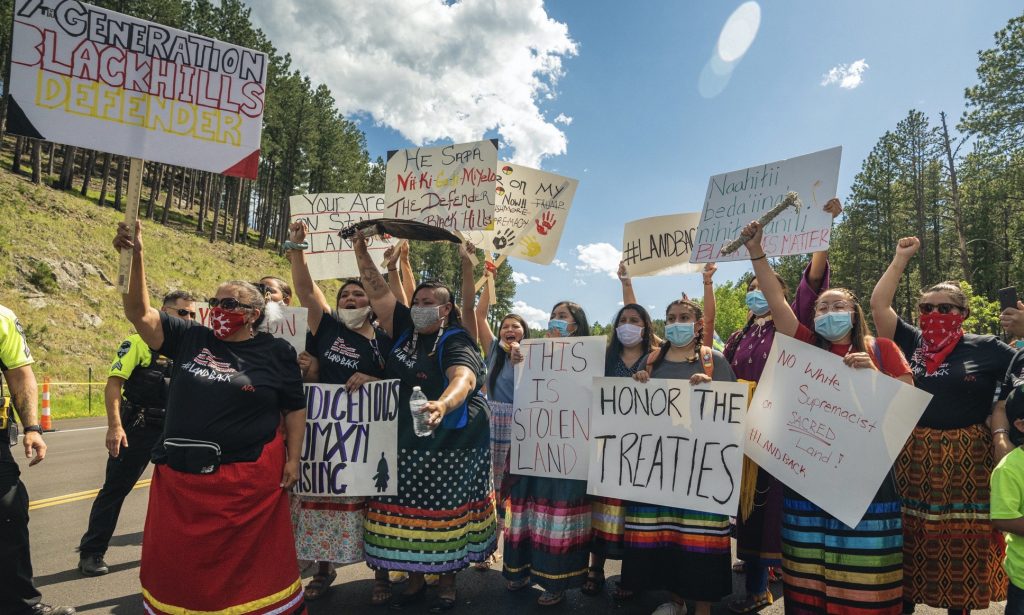
In this work, you’re dealing with gossip, respectability politics and then all these charges where the system is attempting to make a criminal out of you, but the reality is, you’re protesting broken treaties and laws. In the state of South Dakota, Native People are criminalized the moment they are arrested. The State already assumes you’re a criminal.
To be building the biggest Indigenous movement in history while you’re facing 17 years in prison is a fucking uphill battle. You wonder every time you’re getting on a call to raise funds for the cause or when you walk into a meeting, what are the undertones and assumptions being made? Which people aren’t taking meetings with you because you’re facing charges?
They used their positional power to threaten me, but I never stopped organizing in this community.
The Secretary of the Interior Deb Haaland came to the Black Hills, but I wasn’t able to sit down with her and one of the reasons I attribute to that was facing charges at the time. The media created a stigma and false narrative that I’m violent, that I’m a criminal and proceeded to dehumanize me. That’s been a struggle. I’m not complaining about it— just saying that’s what it is. I’ve been doing this long enough to know how this pans out, but it’s still hard, especially when you’re fighting for social justice.
When Indigenous resistance is happening, it doesn’t get celebrated because people are intimidated by our language and the radical nature of the structural changes we are fighting for. This resistance triggers white fragility in that it holds up the mirror to all of them. Certain civil rights leaders might be lifted up as examples of justice if they are more palatable, but Indigenous and more radical Black leaders are often looked at as violent criminals, as if we’re not fighting for the very same liberation.
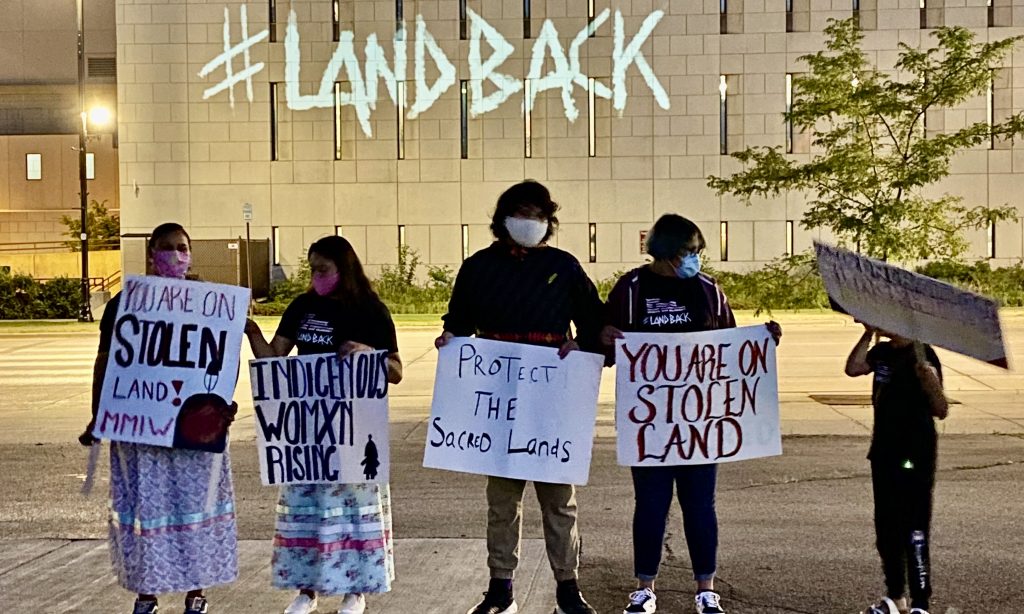
My son and I go everywhere together and the day after I went to jail following my arrest, being out in public was interesting because everyone knows who I am and who my son is and you never know what could happen in those moments. There are times where I’ve walked into restaurants and you could feel that they did not want me there and they did not want my family there. We felt that. As we continued to organize in this community, law enforcement, Pennington County sheriffs, prosecutor– they all targeted the shit out of me and NDN Collective and many people associated with us during this prosecution too, using all sorts of intimidation tactics.
In the lawsuit that we filed against Pennington County, I had a Rapid City Police officer in a totally unrelated action essentially threaten and indicate that he could arrest me because I was in violation of the conditions of my release. This is highly illegal for them to use this as a method to chill my free speech which is a constitutionally protected right. They used their positional power to threaten me, but I never stopped organizing in this community. From July 3, 2020, to the present, we’ve never stopped putting the pedal to the metal in terms of organizing. You continue to fight while you’re facing charges.
We also had many partners in the government who tried to make things happen for us, but my charges made that work hard. Some ten years ago in 2012, I was actually present at the White House Tribal Nations conference, and my work and advocacy was highlighted by President Barack Obama. But flash forward to 2022, and I wasn’t even allowed on the White House campus because of my pending charges. You have to think about how these charges affected various strategies, including funding. I was very transparent with the funders about my legal battle, and also with the resource partners who support NDN Collective. I was happy to say that a vast majority of funders rallied around me and this organization, and they supported us.
I appreciated those prayers. They helped me and my family get through the hard times. I was never alone in the struggle.
However, rumors started circulating about me supposedly having federal charges. My charges were never federal– they were state felonies. When you’re an organizational leader, people will look for ways to discredit you. This happened constantly, and when you don’t know what the outcome is going to be with the legal battles, when you don’t know whether there is going to be a trial, you’re reminded of how this colonial system is fucked up and was never designed to provide justice for Native people. Being in an organization within a movement has been interesting as well, because you have 30 other projects to tend to, which are more important and that you really want to give your attention to, and yet you have this looming decision hanging over your head.
Also because of the stance we took against Donald Trump and Mount Rushmore, I received death threats in the mail and people threatened my life and the organization. Because of what we’re fighting for, my family, this organization, and the community have been deeply, deeply impacted.
Q: This has definitely been a journey, and the struggles are real. On the flip side, what have been some of the bright spots that have come from all of this?
Nick: I’m a longtime sundance participant who has spent my whole life around spiritual hocokas (Lakota spiritual circles) and altars. One of the things I appreciated after the arrests happened and throughout the court process was how many people, from various spiritual circles, not just in Lakota country but throughout Indian Country, would come up to me or reach out to me. Calling, texting, and saying they prayed for us, prayed for me in ceremony. They would say, “The spirits are watching over you.”
Being an individual who goes to inipi (sweat lodge), sundance, and sits around the drum, when someone says that to you, you know they’re legit and that feels good. That’s what protection feels like– spiritual protection.
So, to everybody that did go into ceremony, making those prayers for me and other land defenders, I thank every single one of them. I don’t take it lightly. I appreciated those prayers. They helped me and my family get through the hard times. I was never alone in the struggle. There was never a moment where I couldn’t feel the spirits and that’s because of all the prayers people sent– you know they meant it, and that was a big bright spot for me.
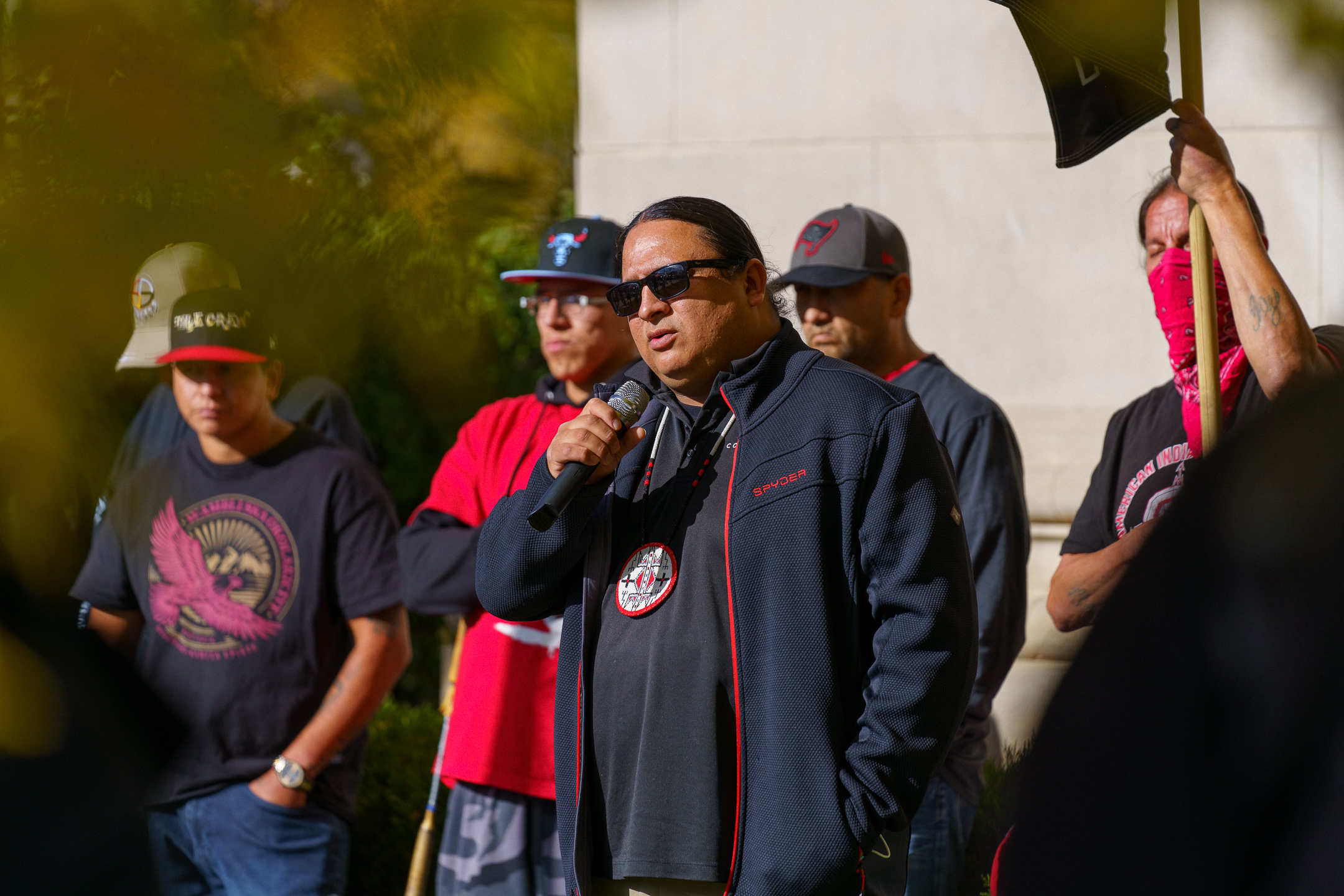
The other big one for me too and one that touched my heart was the amount of elders and old school freedom fighters that would come on out and reach out about how this lifted and inspired them. How it made them feel good to see the next generation of people fighting for the Ȟesápa– that there is a next generation of people fighting for our land. And so that was the other cool thing–just getting that validation and support from the elders, and seeing how much this fight ‘fired them up’ too.
There was an outcry of support from the spiritual realm and throughout the community. Every single time there was a hearing or court date, people always asked, “How can I help?” They would show up. Never once did I walk into that courtroom alone. I walked in with a movement and people supporting me and that felt good and powerful. To have both spiritual support and the support of our people, there was just a lot of beauty that came from this too.
Q: So this was definitely a strategy that required a strong legal component, and we couldn’t have done that without resources. How true is it that if we don’t have resources to fight these legal battles, that all of the folx facing charges from the arrests of July 3 would have all gone to jail and been charged with heftier sentences?
Nick: When you engage in nonviolent direct action (NVDA), you always need to have a legal strategy. Action is only one part of it. As a part of our strategy, we launched the Black Hills Legal Defense Fund (BHLDF) because we expected that the government was going to come in hard, but we were ready for them.The BHLDF was able to take care of all the land defenders who were arrested that day alongside me, in fighting their charges and it helped by providing lawyers for all of them, including the ones in my case. Having really good legal support from our lawyers and the resources for this is absolutely one of the reasons I didn’t end up going to jail.
You look at the prisons right now, the fact people don’t have these resources on a massive scale is one of the reasons why 51-percent of people incarcerated in South Dakota are Native. The system is designed to bleed you of your resources, to drag out the process. It’s designed to cost you as much money as possible. So yes, having resources was absolutely key. But it was also a unique situation. Most of the time engaging in non-violent direct action, we don’t have those legal resources, so we have to find other strategies.
Whenever they try to attack us, eventually the media goes away and you have to create a narrative to remind people that this is happening.
The other resource people also have to recognize is narrative. The quieter we stay when our people are being prosecuted, is how the legal system is able to put us away. Our communications and narrative strategy were also things that helped me stay out of prison. Whenever they try to attack us, eventually the media goes away and you have to create a narrative to remind people that this is happening. When you have the media, you can utilize it to make sure people know that this is still happening. You can continue to hold the mirror up to the system of the injustice that’s happening. When that goes away and you’re the only one facing charges, it’s a lonely place. That’s what they try to do to social justice movements and liberation movements all the time.
When I think of resources, I think of support in the legal battles, and bringing the fight to light using narrative and communication strategies. Even using petitions, at one point there were thousands of people who had signed petitions for these charges to be dropped. In addition, we had a petition against the state prosecutor involved in my case, who engaged in illegal prosecutorial misconduct and violated my free speech rights, and though he didn’t end up losing his position, those signatures were not for nothing. All of these things collectively are different types of ‘resources’ that are key in helping myself and other Land Defenders stay out of jail and instead, keeping us free to continue mobilizing in the streets, doing what we’re supposed to be doing.
Q: As we know here at NDN Collective, the fight for liberation is a long game and each battle, like this one, is still connected to something much greater. Now that your charges have been dropped, what do you and NDN Collective have planned next, and what is the long game there?
Nick: First, is what we did while in the midst of this legal battle. During the arc of these charges over the last two and half years, NDN Collective built the biggest Indigenous movement infrastructure organization in history. At a time in which they were going after me as the founder of this organization, we never stopped what we were doing here. We continued on, launching a culture-based school, the Oceti Sakowin Community Academy. We purchased land back all over north Rapid City to start developing affordable sustainable housing for our people– and we’re currently engaged in so many efforts here locally.
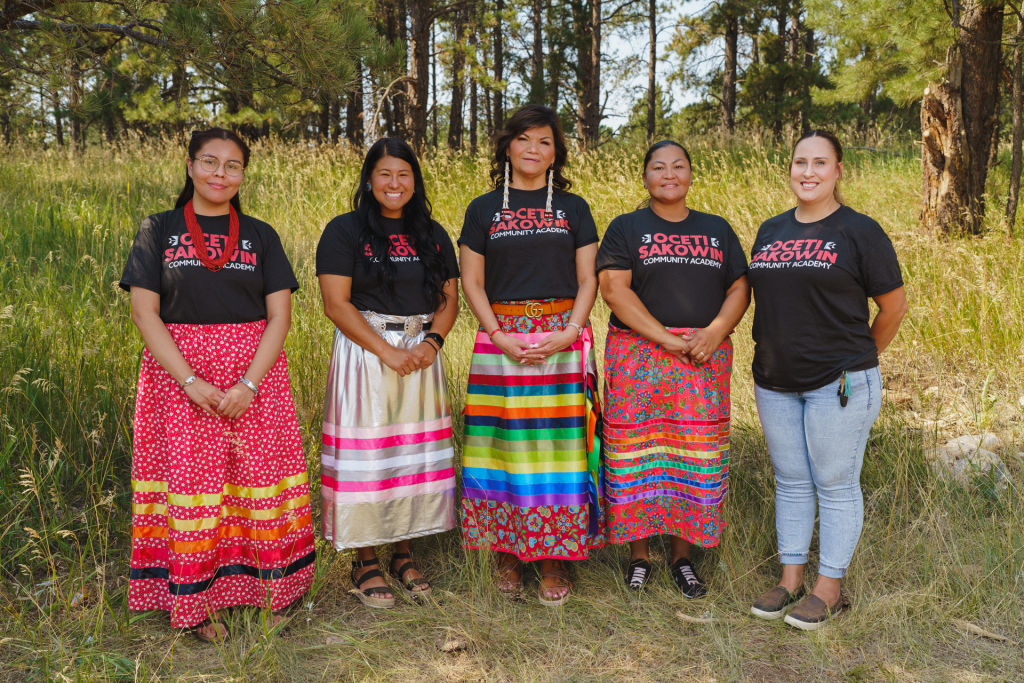
We’ve been able to resource the vast majority of Indigenous-led organizations and movements throughout the arc of this case, too. We have funded 40 million dollars to over 600 Indigenous organizations from the Gwich’in up north, who are fighting in the arctic wildlife refuge, all the way to the Zapatistas in the south who are rebuilding their communities and fighting for their own land reclamation and stewardship practices. We were also one of the first organizations in the country to respond to the Kanaka resistance in protection of Mauna Kea. It’s pretty powerful to think that while this case was ensuing, NDN Collective continued to do all of the things that we’ve been doing.
Where do we go from here? We have already laid a really solid foundation. We will continue to increase the amount of resources that are going to frontline struggles throughout Indian country and the Indigenous world. We’ll continue to finance, fund, and support just transition work in helping to reestablish Indigenous economies based on our values while also creating jobs for our people. We will continue building an entire community in north Rapid City that provides sustainable affordable housing for the long haul. We launched a community land trust, which is a communal ownership model to build affordable housing while creating healthy communities and housing for our people. We’re the same people that are doing all of this amazing community development work, job creation, and we’re going to continue our resistance and policy work too.
NDN Collective is going to double down on fighting those corporations right here locally who are engaged in massive amounts of mining in Ȟesápa, the Black Hills. There are some huge environmental justice and landmark battles happening right here in the Black Hills. We’ll be fighting alongside many others and for the return of Ȟesápa. I would still like to see all of the public lands in the Black Hills returned to Indigenous people. So, I think we’re going to be looking at a policy and organizing strategy that looks at reintroducing a new bill, potentially a bill that will be similar to something like the the Bradley Bill that looks at trying to return all of the public lands in the Black Hills back to the Lakota while getting these mining operations shut down.
We are going to continue to advance Indigenous solutions for climate change, fight for land back throughout the Indigenous world– there are so many things on our horizon.
To begin in the spring of 2023, we’re going to be breaking ground on an Indigenous restaurant right in front of our headquarters here in North Rapid. The restaurant will be a place where we can share Indigenous food, culture, and create jobs for our people and home. We are going to continue to advance Indigenous solutions for climate change, fight for land back throughout the Indigenous world– there are so many things on our horizon.
We are doubling down on increasing our muscle around local community organizing, training more people, and building skills around non-violent direct action. NDN Collective is not going anywhere. We will continue to move resources out of white-led institutions into Indigenous-led ones to support this ongoing movement while continuing to tell these stories through our platforms.
One big fight that we are continuing locally is that we led the strategy and resistance against the Grand Gateway hotel who refused service to Native people. In doing that, they violated our civil rights. We’re going to be here for the long haul dismantling white supremacy in this community. The only way to dismantle white supremacy and tackle racism is to create an entirely new system altogether. I have no doubt in my mind that NDN Collective is going to play a fundamental role in making this happen for our community– healing our communities and our people, supporting the self-determination of Indigenous communities everywhere. We aren’t going anywhere.

We also recognize that a dichotomy exists between our people’s well-being and rights, and Rapid City’s carceral forces and overarching legal system, which play active roles in systemic racism. When NDN Collective mobilized in this community against the Grand Gateway Hotel, there were Pennington County prosecutors and officers who showed up to that protest to march with us. They acknowledged what was happening, that there was an injustice, but they didn’t view their prosecution of me and attempt at putting me away for 17 years, as racist. When they showed up to protest alongside us I called them out and they left. I’ll be damned if they think they can lock up our people and in the same instant attempt to stand beside us in protest of racism and violence of which they actively perpetuate. Therein lies the dichotomy, where I’m facing these charges while continually asserting that they are racially and politically motivated, with individuals such as Mark Vargo, Attorney General of South Dakota, blatantly ignoring this fact. We’re gaslit every single day as Indigenous Peoples.
Recently we were able to witness US Attorney General Merrick Garland, the highest ranking law enforcement officer in the nation, speaking to Tribal leaders at the White House Tribal Nations Summit, expressing the Department of Justice’s support of the civil rights lawsuit against the Grand Gateway Hotel. However, at the same time they are expressing that support, the Department of Justice and Merrick Garland haven’t made a decision to work alongside the White House to release Leonard Peltier, who is the longest existing political prisoner being held in the United States.
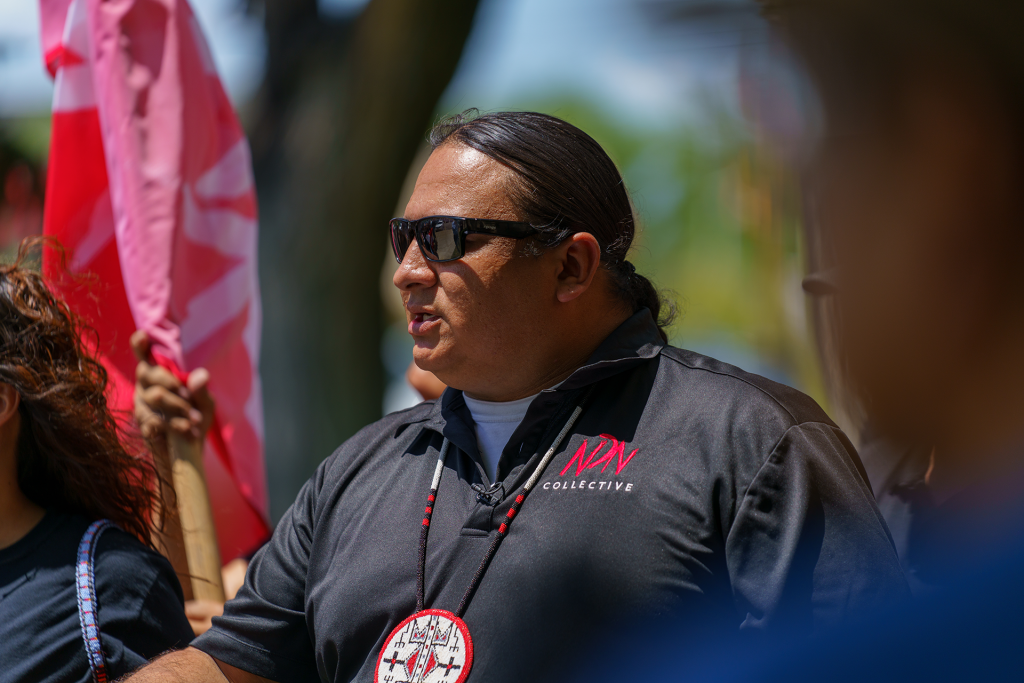
We continue to organize, build power and strengthen our collective because of these glaringly evident examples of the dichotomy, contradiction and outright hypocrisy that exists between the American legal system and Indigenous Peoples. One of the main reasons why I’m not going to prison is because of the movement and the people, who made it clear that this pursuit of “justice” was hypocritical. It was our people who wore down all those who attempted to carry this charge forward, essentially tiring out the system. We dug our heels in and mobilized, collectively.
Q: Do you have any words you’d like to share with supporters and allies?
Nick: First, I want to end by thanking the people, because I would be in prison right now if the people didn’t mobilize. If they weren’t outraged and in the streets or hadn’t donated to the Black Hills Legal Fund, if they hadn’t signed petitions or commented on articles and most importantly, if they hadn’t prayed.
It makes me think about the larger cause, which obviously isn’t about me. It’s about the struggle and liberation of our people and how we move them forward. When I think about the return of the Ȟesápa, starting the Oceti Sakowin Community Academy, eventually developing an Indian center in Rapid City and fighting climate change, I recognize that we are successful in these endeavors because we walk towards them in solidarity.
To everyone that supported me, I am deeply, deeply grateful and fired up to continue supporting and rolling up our sleeves for the Relatives here in the Black Hills and across Indian Country.
Related Stories
Press Release | All Charges Dismissed Against Nick Tilsen in 2.5 Year Long Case
Press Release | Nick Tilsen’s Evidentiary Hearing Result: Judge Takes Defense Under Advisement
Press Release | Nick Tilsen Files Motion to Dismiss Case, Citing Prosecutorial Misconduct and Constitutional Violations
Press Release | NDN Collective President and CEO Nick Tilsen Will Go To Jury Trial for Felony Charges
Press Release | NDN Collective President and CEO Nick Tilsen Faces 15 Years in Prison for Protest Against White Supremacy
Blog | Nick Tilsen Statement Upon Release From Arrest: “We Have To Act in Courage and in Bravery”
Press Release | Indigenous Land Defenders Released from Jail after Mt. Rushmore Trump Visit, Prosecutor Launches Campaign of Charges Against Them

